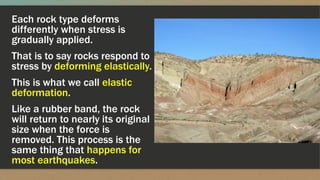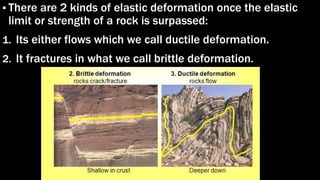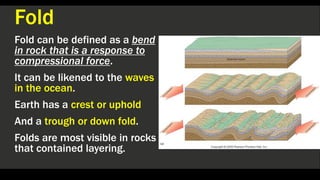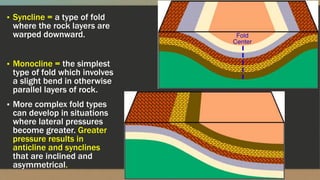Deformation of Crust
- 1. Deformation of the Crust Prepared by: Jerome A. Bigael, Leyte Progressive High School
- 2. Deformation Is the process by which the crust is deformed along tectonic plate margins. Deformation produces a variety of geologic structures such as folds, faults, joints, and foliation.
- 3. Each rock type deforms differently when stress is gradually applied. That is to say rocks respond to stress by deforming elastically. This is what we call elastic deformation. Like a rubber band, the rock will return to nearly its original size when the force is removed. This process is the same thing that happens for most earthquakes.
- 4. ▪ There are 2 kinds of elastic deformation once the elastic limit or strength of a rock is surpassed: 1. Its either flows which we call ductile deformation. 2. It fractures in what we call brittle deformation.
- 5. In other words, for deformation of rock to occur, the following conditions must be met: 1. The rock material must have the ability to deform under pressure and heat. 2. The higher the temperature of the rock the more elastic it becomes. 3. Pressure must not exceed the internal strength of the rock, otherwise, fracturing occurs. 4. Deformation must be applied slowly.
- 8. ▪ In general, you can say that a rock has been deformed if it has been: ▪ Translated (move) from its original position ▪ Changed in orientation (folding, rotation or tilting) ▪ Changed in shape(distortion)
- 9. Fold Fold can be defined as a bend in rock that is a response to compressional force. It can be likened to the waves in the ocean. Earth has a crest or uphold And a trough or down fold. Folds are most visible in rocks that contained layering.
- 10. 3 types of Folds ▪ The common types of folds are the, anticline, syncline and monocline. ▪ Anticline = is a convex up fold in rock that resembles an “arch like”
- 11. ▪ Syncline = a type of fold where the rock layers are warped downward. ▪ Monocline = the simplest type of fold which involves a slight bend in otherwise parallel layers of rock. ▪ More complex fold types can develop in situations where lateral pressures become greater. Greater pressure results in anticline and synclines that are inclined and asymmetrical.
- 12. Faults Faults form in rocks when the stresses overcome the internal strength of the rock resulting in a fracture. It is defined as the displacement of once connected blocks of rocks along a fault plane.
- 13. ▪There are several kinds of faults, which are named according with the type of stress that acts on the rock and by the nature of the movement of the rock blocks or either side of the fault plane.
- 14. Type of Faults ▪ Dip-slip-fault are faults in which the movement is primarily parallel to the inclination or dip of the fault surface. 2 major types of dip slip fault Normal fault = occurs when tensional forces act in opposite directions. This is sometimes called “gravity fault”. Reverse fault = reverse fault develops when compression forces exist. Compression cause one block pushed up and over the other block.
- 15. Graben Fault Produced when tensional stresses result in the subsidence of a block of rock. On a large scale these features are known as rift valleys.
- 16. Horst Fault ▪ The development of two reverse fault causing a block of rock to be pushed up.
- 17. Strike-slip fault Are vertical in nature and are produced where the stresses are exerted parallel to each other. A transform fault is a special kind of strike-slip fault that cuts through the lithosphere and accommodates motion between two large crustal plates.
- 18. Oblique-slip fault Happens when many faults are mixed in slip type.

















